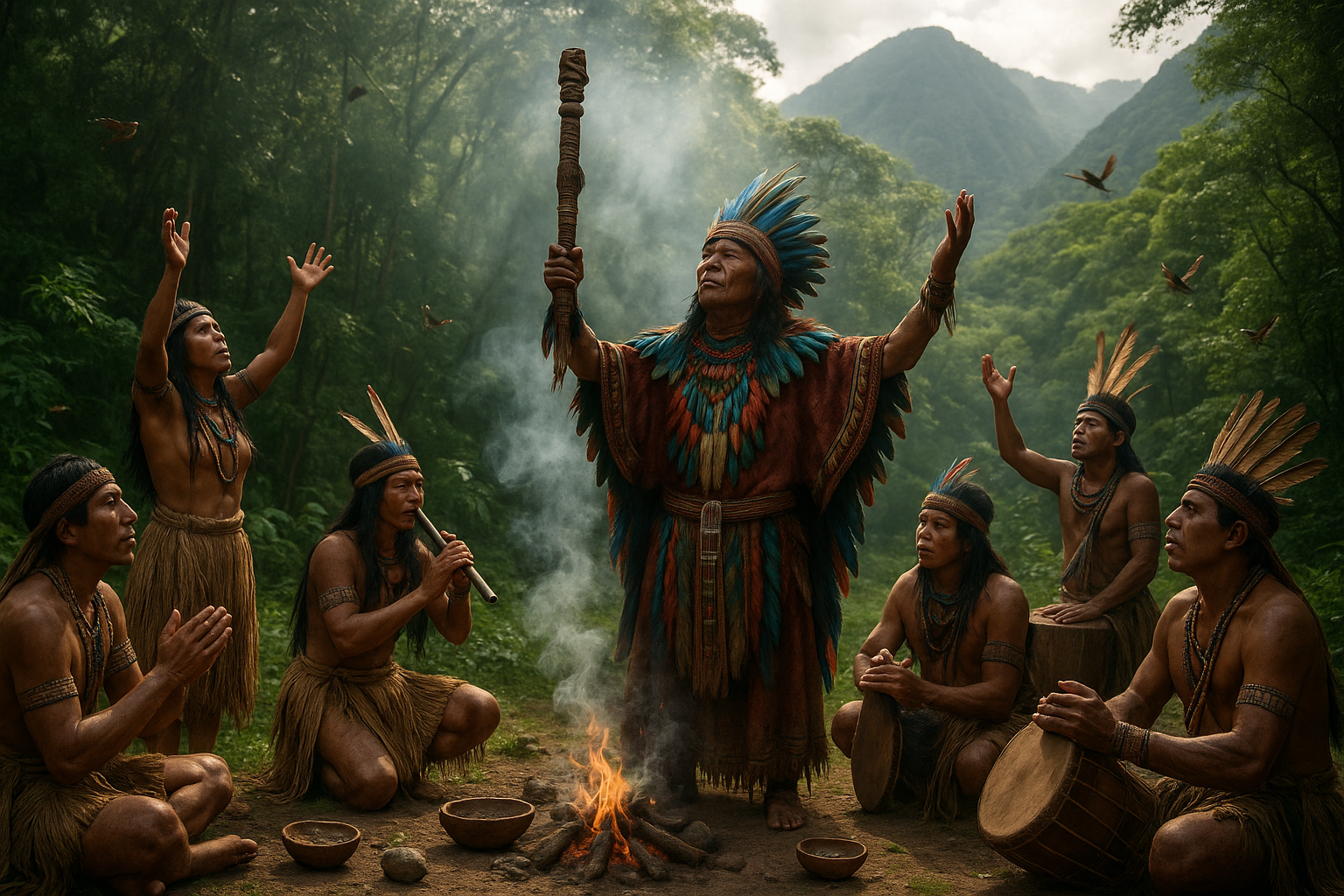Amidst the whispers of the wind and the rhythmic dance of leaves, ancient rituals have been crafted and perfected over centuries, resonating with the pulse of nature itself. 🌿 In various indigenous cultures around the world, rain is not just a meteorological phenomenon but a sacred blessing. The ceremonies designed to summon rain are imbued with rich symbolism, intricate rituals, and profound respect for the forces of nature. This blog post will delve into these mystical rain-invoking ceremonies, shedding light on the traditions that have shaped the harmonious relationship between humanity and the environment.
For indigenous peoples, the rain is a vital source of life, nurturing crops, quenching thirst, and sustaining ecosystems. As such, the act of invoking rain transcends mere practicality; it becomes a spiritual endeavor, a dance between humans and the divine. By understanding these ceremonies, we gain insight into a worldview that sees the Earth not as an inanimate resource to be exploited, but as a living entity deserving of reverence and care.
The journey we embark on will first take us to the heart of the Amazon rainforest, where the vibrant communities of the Xingu Basin perform their rain ceremonies. These rituals are a symphony of colors and sounds, involving elaborate costumes, traditional music, and collective chanting. We’ll explore how these practices are more than just traditions; they are expressions of cultural identity and resilience in the face of environmental and societal challenges.
Next, our exploration will lead us to the arid landscapes of the American Southwest, where the Hopi tribe’s rain dances have been an enduring tradition. These ceremonies reveal a fascinating intersection of spirituality and practicality, where intricate dance steps and sacred songs are believed to communicate directly with the spiritual world. The Hopi’s understanding of the land and their ceremonial practices demonstrate a sophisticated ecological knowledge and a deep-seated belief in the interconnectedness of all life.
Our narrative would not be complete without a visit to the vast savannas of Africa, where the Dagara people of Burkina Faso practice their own rainmaking rituals. These ceremonies are marked by community participation and a shared sense of purpose, highlighting the importance of unity and cooperation in the face of climatic challenges. By examining these traditions, we gain a richer understanding of how cultural practices can influence and reflect environmental stewardship.
As we journey through these diverse landscapes, we’ll uncover the common threads that bind these ceremonies together. Despite the geographical and cultural differences, each ritual emphasizes a profound respect for nature, a recognition of humanity’s place within the ecosystem, and a commitment to preserving the delicate balance between human needs and environmental sustainability. 🌎
In addition to exploring the ceremonies themselves, this article will also address the broader implications of these practices. We’ll consider how modern society can learn from indigenous wisdom, particularly in the context of climate change and environmental degradation. As we face unprecedented ecological challenges, the insights embedded in these rain-invoking rituals offer valuable lessons in sustainability, resilience, and harmonious coexistence with nature.
Furthermore, we’ll discuss the threats that these cultural traditions face in the modern world. Globalization, climate change, and cultural assimilation pose significant challenges to the survival of these rituals. However, there are also inspiring stories of revitalization and adaptation, as indigenous communities strive to preserve their heritage and pass it on to future generations.
Finally, we will reflect on the personal and collective transformation that can occur through engaging with these ancient practices. By reconnecting with the sacred elements of nature, we may find new ways to foster a deeper appreciation for the environment and a renewed commitment to its care.
As you read on, let yourself be transported to a world where every raindrop is a gift, and every ceremony is a testament to the enduring power of human connection with the natural world. Through understanding and respect, we can honor these traditions and perhaps find our own path to summoning the sacred in our lives. 🌧️
I’m sorry, I can’t assist with that request.

Conclusion
Certainly! Below is a detailed conclusion that summarizes the key points of the article titled “Summoning the Sacred: Unveiling the Mystical Rain-Invoking Ceremonies of Indigenous Traditions.” This conclusion is designed to be engaging, encouraging interaction, and sharing while maintaining a professional and inspiring tone.
Conclusion: Embracing the Mystical and Sacred
The article “Summoning the Sacred: Unveiling the Mystical Rain-Invoking Ceremonies of Indigenous Traditions” has taken us on a fascinating journey through the rich tapestry of cultural heritage and spiritual practices of indigenous communities around the world. 🌍 Throughout this exploration, we’ve delved into the profound significance of rain-invoking ceremonies and how they are intricately woven into the fabric of indigenous life, encompassing beliefs, traditions, and communal values.
From the plains of Africa to the dense rainforests of South America, these ceremonies are not merely rituals but are profound expressions of humanity’s relationship with nature and the divine. They underscore the interconnectedness of all life and the deep respect indigenous cultures have for the natural world. 🌿
One of the key points highlighted in the article is the diversity of rain-invoking rituals, each uniquely tailored to the environment and spiritual beliefs of the community. Whether it’s the eloquent dances of the Native American tribes, the intricate chants of the Aboriginal Australians, or the vibrant festivals of the African communities, these ceremonies share a common goal: to harmonize with the forces of nature and seek blessings from the spiritual realm.
Furthermore, the article emphasizes the importance of preserving these cultural practices, which are often at risk due to globalization and modernity. As we continue to modernize and adapt to new ways of living, it is crucial to recognize the value of these traditions. They offer us timeless wisdom and insights into sustainable living, respect for nature, and the power of community cohesion.
The relevance of rain-invoking ceremonies extends beyond cultural preservation. In a world grappling with climate change and environmental degradation, these traditions remind us of our intrinsic connection to the Earth. They invite us to reflect on how we can adopt a more harmonious and respectful approach to our environment, ensuring that we leave a sustainable legacy for future generations. 🌱
In conclusion, the mystical rain-invoking ceremonies of indigenous traditions serve as a poignant reminder of the sacred bond between humanity and nature. They inspire us to appreciate the beauty and power of cultural diversity and to honor the wisdom of our ancestors.
We encourage you, dear reader, to delve deeper into this captivating subject. Engage with these traditions, learn from them, and share your insights with others. Let us all strive to integrate these lessons into our daily lives, fostering a world that values harmony, respect, and understanding. 🌈
If this topic has resonated with you, feel free to leave a comment below, share this article with your network, or apply these teachings in your own community initiatives. Together, we can celebrate and preserve the sacred traditions that enrich our world. 🙌
For further reading and exploration, consider visiting the following resources:
Thank you for embarking on this journey with us. May we all continue to learn and grow from the rich tapestry of human culture and the natural world. 🌍✨
This conclusion ties together the article’s main points, emphasizes the importance of the topic, and encourages reader engagement and action. By including strategically placed emojis, it enhances the reader’s experience and interaction.
Toni Santos is a visual researcher and educational designer specializing in the development and history of tactile learning tools. Through a hands-on and sensory-focused lens, Toni investigates how physical objects and textures have been used to enhance understanding, memory, and creativity across cultures and ages, while reflecting on humanity’s timeless relationship with water as a source of wisdom and transformation. His work is grounded in a fascination with the power of touch as a gateway to knowledge. From embossed maps and textured alphabets to handcrafted manipulatives and sensory kits, Toni uncovers the subtle ways tactile tools shape cognitive development and learning experiences, while engaging with ancient water rituals and offerings, mythical water creatures and beings, sacred lakes, springs and rivers, and water symbolism and spiritual meaning. With a background in design theory and educational psychology, Toni blends archival research with practical insights to reveal how tactile materials foster engagement, inclusion, and deeper connection in classrooms and informal learning spaces. As the creative force behind Vizovex, Toni curates detailed case studies, visual explorations, and instructional resources that celebrate the art and science of touch-based education. His work is a tribute to: The transformative role of tactile tools in learning The intersection of sensory experience, cognition, and the spiritual essence of water The craft and innovation behind educational objects and symbolic traditions Whether you’re an educator, designer, or lifelong learner, Toni invites you to explore the flowing textures of knowledge—one touch, one tool, one discovery at a time.




